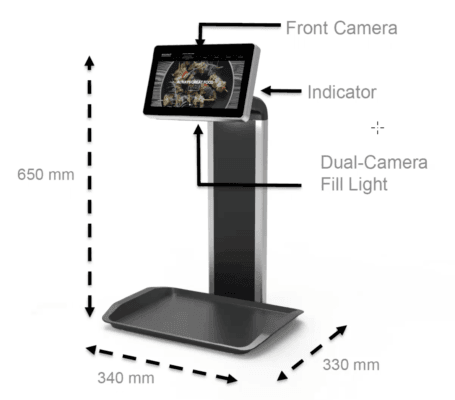Computer Vision = Better Service + Lower Costs

RT Baker House in Hsinchu, Taiwan, is one of the most famous bakeries in the region. Widely known for an impressive array of delicious cakes and breads, it’s also known for long lines and lengthy wait times. Improving customer satisfaction could not be enhanced by just adding more staff. So where humans weren’t the answer, the bakery turned to a computer vision-based POS system developed by Flytech and its subsidiary Berry AI (Video 1).
Video 1. RT Baker House computer vision POS system in action. (Source: Flytech)
As a result, RT Baker House was able to dramatically improve customer satisfaction by implementing a seamless checkout process that looks like this:
- Bakery patrons simply select their items, place them on a tray, and proceed to checkout.
- The tray is placed in the field of view of the K750/K750 computer vision system, which identifies goods and passes that information to a POS system without human cashiers entering any data.
- Secure payments are handled on a third-party POS system by a cashier, but could also be done via self-checkout.
This improved, CV-enabled process has reduced customer wait times by 30 percent. It is also transforming RT’s bottom line.
Shorter Lines with Computer Vision and AI
The heart of the bakery computer vision checkout system is the Flytech K755 fanless panel PC. The capacitive touch system is based on a 6th generation Intel® Core™ processor supported by 4 GB of external DDR3L memory. It also sports multiple cameras—one on the front panel and dual cameras on the underside of the bezel, which are responsible for scanning the baked goods selected by customers.
The two scanning cameras are also accompanied by fill lights and special filtering functions that ensure the system captures the highest-resolution images possible even in the bakery’s varying lighting conditions (Figure 1).

The @FlytechCM team was able to develop inferencing algorithms with over 99 percent detection accuracy. Better than human
object recognition.
But the smart checkout system comes to life thanks to convolutional neural network (CNN) algorithms and fast Fourier transforms (FFTs) capable of identifying minute differences between almost 100 different baked goods.
The algorithms were developed over a 10-week period by Berry AI, which used a training data set of approximately 10,000 product images provided by the bakery. After a week of labeling the data, the team was able to develop inferencing algorithms that yield better than 99 percent detection accuracy. In other words, better than human object recognition.
What’s even more impressive is that these neural network algorithms can identify several different items on a tray simultaneously and in real time, all while executing completely on the Intel Core processor at the edge and consuming just 2 GB of memory.
To optimize the computer vision algorithms for execution on a fanless edge system, the company leveraged the Intel® OpenVINO™ Toolkit. The deep learning development suite helps engineers maximize the performance of computer vision workloads across a variety of compute architectures, including CPUs, GPUs, FPGAs, and vision processing units (VPUs).
According to Ian Zeng, Product Manager for Computer Vision at Flytech, OpenVINO not only reduced the overall memory footprint of CNN algorithms, it also reduced the execution time to less than 0.1 seconds when running on the Intel Core processor.
From Cookies to Kiwis
The highly accurate K750/K760 computer vision system was able to reduce labor costs on multiple fronts. Since fewer staff members have to be well-versed in different baked goods, the bakery has eliminated up to 50 percent of its training costs. And thanks to the shorter lines and greater efficiency afforded by the smart checkout system, its overall labor requirements have dropped by roughly 20 percent.
Given the success of the solution, AI computer-vision systems are now expanding into additional food-recognition applications.
As RT Baker House deploys the smart checkout system throughout its locations, new applications of Flytech/Berry AI technology are in the works. In grocery stores, for example, its solution can be leveraged in even more demanding object recognition tasks, such as distinguishing between different types of produce.
Because different varieties of apples or various types of oranges can have almost identical colors, shapes, and sizes, it has traditionally been very difficult for people—much less computer vision algorithms—to tell them apart. But advanced algorithms from Berry AI now can distinguish between nearly identical-looking tomatoes, apples, pears, and kiwis using the same K755 infrastructure.
But even on a broader scale, computer vision solutions like the K755 panel PC can be leveraged by retailers to replace any type of traditional barcode scanning. By doing so, these vendors can eliminate the overhead of bar code infrastructure, improve hygiene by minimizing the amount of physical interaction with foodstuffs, and potentially enjoy the customer satisfaction and cost reductions already underway at one of Taiwan’s most famous bakeries.